Stevens Brothers
(Wolverhampton) Limited
| The Stevens brothers must have been devastated after the
closure of A.J.S. in October 1931. They lost nearly
everything in the process, and yet decided to roll up their
sleeves and start all over again from the beginning. Luckily
they still owned their old Retreat Street premises, which in
the intervening years had been used by the Stevens Screw
Company Limited. Working on a shoestring they set up a new
company called Stevens Brothers (Wolverhampton) Limited, in
May 1932. The directors were the five Stevens brothers;
Harry, George, Joe, Jack and Billie. Working around the
clock, and assisted by a number of unpaid volunteers, they
managed to design and develop the 'Stevens Light Commercial
Vehicle', a three wheeled van.
| Read about the
Retreat Street factory |
 |
|
|
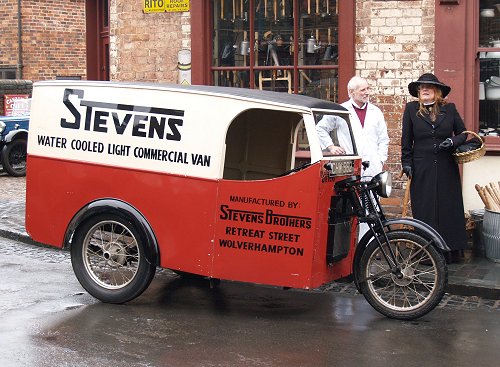
The Stevens 3-wheeled van that can be
seen at the Black Country Living Museum. |
It was based on a prototype three wheeled vehicle, built
in 1921 at the A.J.S. works on Graiseley Hill, that had two
wheels at the front and one at the rear.
The Stevens van used motorcycle technology, with a single
wheel at the front, carried on heavy duty motorcycle forks.
There was a steering wheel, connected to the front wheel
by two roller chains, and a water-cooled single-cylinder,
side valve, Stevens 588c.c. engine, with dry sump
lubrication.
The rear wheels were chain driven from a Burman 3 speed,
plus reverse, gearbox. |
| The van was fitted with a foot operated kickstart lever,
and a throttle, mounted in the centre of the steering wheel.
Initially a full-width bench seat was fitted but soon
replaced by a large motorcycle saddle. The bodies were
bought-in and had a capacity of 91cu.ft.
Initially no front doors were fitted, they became
standard at a later date. The vehicle weighed 7.75cwt. and
could carry 5cwt. It had a top speed of about 45m.p.h. and
sold for £83.
From late in 1932 the vans were also built in London by
Bowden (Engineers) Ltd., who had a manufacturing agreement
with Stevens.
The vans sold quite well, and a building across the road
in Retreat Street was rented from storage and furniture
removers, S. Lloyd & Sons, so that production could be
stepped-up.
The vans were assembled in batches of six. When one batch
was sold, work could begin on the next batch. |
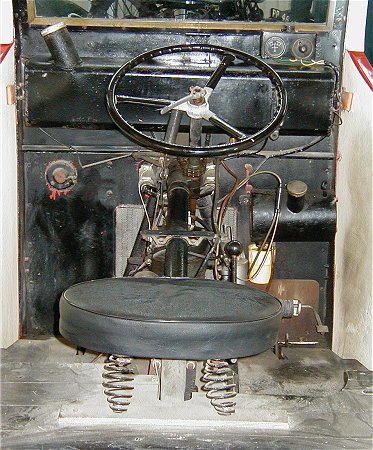
Looking through the back doors of the Stevens
van at the
Black Country Living Museum. |
|
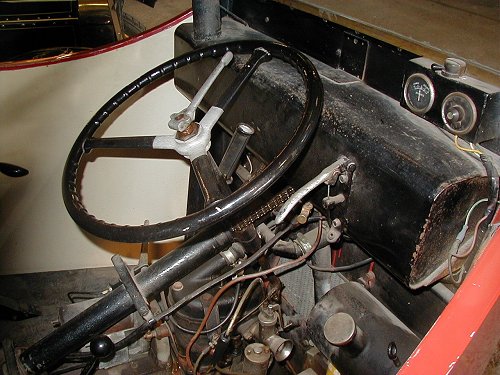
A close-up view of the steering
wheel and engine in the Stevens van at the Black
Country Living Museum. |
An improved version was launched in
October 1935 with an improved drive. The earlier chain
had a habit of breaking, and so it was replaced by a drive
shaft, which required the repositioning of the gearbox.
The improved van could now carry 8cwt.
and sold for £93.9s.0d. and was also available as an open
truck.
 |
| Read
about the new version of the van |
|

A recently discovered Stevens three-wheeler which
is about to be restored. Courtesy of Ken Norton. |
|
Because the company ran on a
shoestring, the expensive up-to-date machinery that had been
in use at Graiseley Hill, was not affordable. As a result
everything had to be finished by hand.
The late Geoff Stevens, who worked at
the company during the early days, remembered making cams by
roughly cutting out a circle, then hand filing it to the
correct profile.
Production continued until late in
1936, by which time sales declined, because customers
preferred the comfort and convenience of a 4 wheeled van.
It is believed that around 500 Stevens
vans were built, of which only a few are known to have
survived. |

An advert from April 1933. |

A drawing of the van. Courtesy of the late Geoff
Stevens.
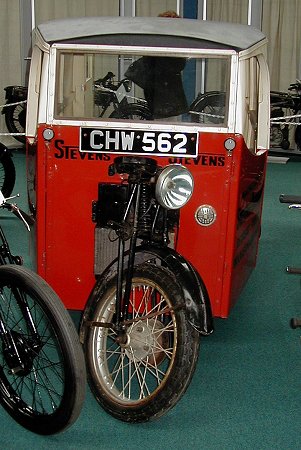 |
|
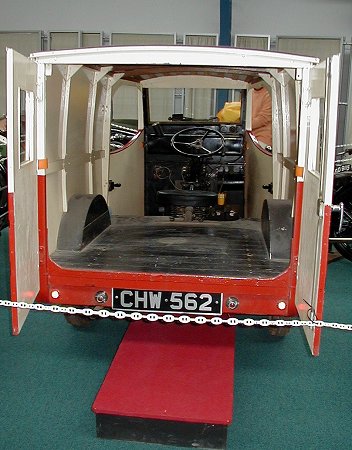 |
|
A front and rear
view of the Stevens van that's in the collection at the
Black Country Living Museum. |
| Stevens Brothers also produced a number
of engines for E. C. Humphries of the O.K. Supreme Company,
and A.J.W. using the 'Ajax' name.
It was clear that the
Stevens company could not support all five directors, and so
in 1934 Joe and Jack left to start their own company,
Wolverhampton Auto-Machinists Limited, which carried out
jig-boring, and produced jigs, and fixtures for the
engineering trade.
The Stevens Motorcycle |
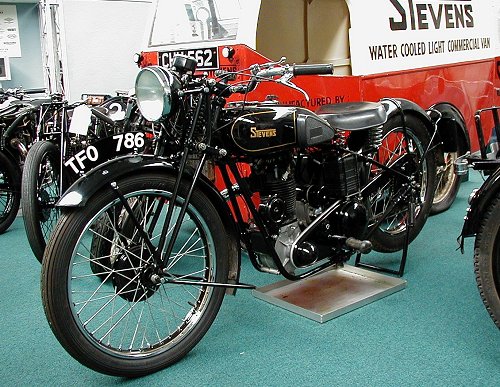
The Stevens 250c.c., o.h.v. machine
that's on display at the Black Country Living Museum, Dudley. The machine was built in 1934. |
In March 1934 the three brothers
re-entered the motorcycle market with two new machines,
designed by Harry Stevens.
They were called the 'D.S.1' and the 'U.S.2', and were
sold using the 'Stevens' name.
Luckily, after the sale of A.J.S., Matchless had left some
jigs and parts behind, which were used in the manufacture of
the new machines.
The machines were powered by a 250c.c., single cylinder,
overhead valve engine, that was very similar to ones used in the later
A.J.S. machines.
The 'D.S.1' had a down-swept, chromium plated exhaust
pipe, whereas the 'U.S.2' had an un-swept exhaust. |
| The machines were fitted with a 4 speed Burman gearbox
and a multiple plate clutch, Lucas 'Magdyno'
ignition, with the magneto mounted behind the cylinder, and a 6 volt lighting system.
Other features included an oil pump fitted in the fully
enclosed oil bath chaincase, a 3 gallon black petrol tank
with gold lining, and a total loss lubrication system, with
the rockers lubricated by grease. The rockers were mounted
on side plates like the much earlier A.J.S. ‘Big Port’
engines. |
| The engine was mounted vertically in a modern twin
downtube frame. Both the handlebars and the seat were fully
adjustable.
Both models were
priced at £51.
Due to lack of money the company operated on a 'hand to
mouth' basis and built the motorcycles in batches of 12.
The brothers couldn't afford to start work on a new batch
until the last batch was sold.
The motorcycles were assembled in the building across the
road that was rented from the furniture removers and storage
company, S.
Lloyd & Sons. |
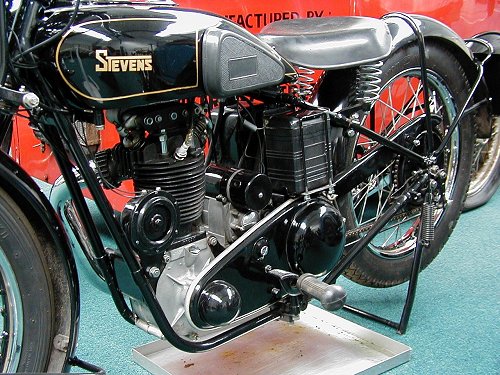
A close-up view of the Stevens machine
at the Black Country Living Museum. |
|

Another view of the Stevens machine at
the Black Country Living Museum. |
Harry Stevens had an office with a drawing board in the
building, where he could work quietly without being
disturbed.
The building was later acquired by Rediffusion, the original
cable radio and television company.
The machines were road tested by a number of popular
motorcycle magazines and given excellent reviews. They were
described as ranking amongst the best, which is a tribute to
the Stevens family, especially considering the primitive
conditions at Retreat Street. |
| A small number of minor improvements were made for the
1935 season and two 350c.c. models were launched. They were identical to the earlier machines except for a
larger engine, and different gear ratios.
The first model, the 'H.L.3' had a high level exhaust
system, the second, the 'L.L.4' had a low level exhaust.
The machines had a top speed of 67m.p.h., and excellent
brakes. Both machines were priced at £52.
In April 1935 a 500c.c. machine was
added to the product range. It had a heavier frame, a longer
wheelbase, and fittings for the attachment of a sidecar. It
sold for £63. A competition version was also available, for
£69. It had a close ratio gearbox and narrow mudguards. |
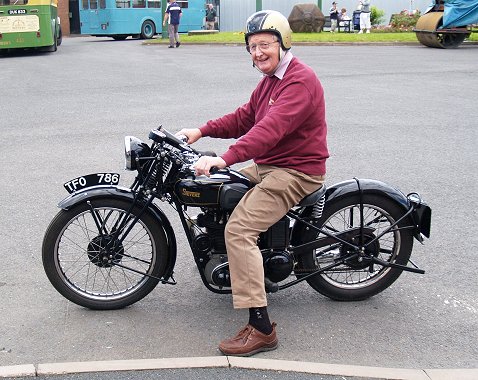
Trevor Davies astride the museum's
Stevens machine. |
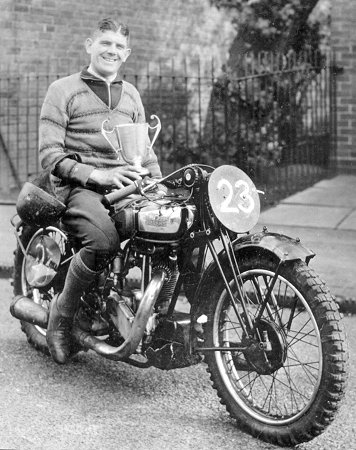
Tommy Deadman on his Stevens motorcycle in
1935. That year he had a very successful season and is seen holding
one of his many trophies. Courtesy of the late Jim Boulton. |
In the autumn of 1935 cosmetic changes
were made to the 500c.c. model. The lining on the tank was
given a thin blue edging, as were the black centres of the
chromed wheel rims, and the old fish-tailed silencer was
changed to a less-swept megaphone silencer. The
machines were proving to be popular, about 200 were produced
each year.
The brothers decided to try and boost sales by
entering their machines in competitions. Tommy Deadman, the
chief tester, entered many competitions and was very
successful on his Stevens machine.
The 1937 machines included a larger
petrol tank, and a megaphone style silencer. Motorcycle
production reluctantly ended in the summer of 1938 when the
country was preparing for an inevitable war. The brothers
realised that during the war, civilian motorcycle production
would cease, and a small company like theirs would not
be able to obtain contracts to build motorcycles from the
War Department. As a result they decided to concentrate on general
engineering work.
During the five years or so of motorcycle
production, around 1,000 Stevens machines had been built.
The last two Stevens motorcycles to leave the works were
specially built for
two members of the Stevens' family, Alec, who was Joe's son
and Jim, Billie's son. |
| In 1938 Harry designed an engine for
George Brough of Nottingham who built the famous Brough
Superior motorcycles. The engine was for a special high quality
machine called the ‘Brough Dream’, later called the ‘Golden
Dream’.
It was to be displayed at the 1938 Motor Cycle Show at Earls Court.
The 1,000c.c. engine and 4 speed
gearbox was completed on time, but only a single prototype
machine was built. |

A Stevens engine. Courtesy of the late
Jim Boulton. |
|
A Stevens Brothers advert in the
November 1938 edition of Flight Magazine lists the following
trade services: light engineering work, machined parts,
assemblies, wire & tube manipulators, welding, light
presswork, etc.
By the late 1930s age was catching up
with the brother’s father, Joseph Stevens and so his
youngest son Billie took over the running of the Stevens
Screw Company, which by the early 1950s employed over 70
staff. Production consisted of hundreds of different small
parts including bolts, nuts and screws, in ferrous and
non-ferrous metals, made from the bar.
In 1938 Billie’s son Jim began to work
at Stevens Brothers after leaving school.
During the Second World War Stevens
Brothers manufactured and machined components for most of
the leading aircraft companies, including Bristol and Fairey
Aviation, Avro, Handley Page, etc., and were sole manufacturers
of the torpedo depth setting gear fitted to every Fairey Swordfish torpedo
bomber. At the time Stevens Brothers were much sought after
to take on jobs that other businesses could not, or would
not do.
After the war, the firm carried out light
engineering work, and also produced office equipment for Ellams Duplicators, under licence.
In the 1950s Jim Stevens took the
decision to sell Stevens Brothers (Wolverhampton) Limited.
By this time his father and uncles had died, and the sale
would allow him to concentrate on the running of the Stevens
Screw Company Limited.
Stevens Brothers was acquired by Leo
Davenport, a successful businessman, who had previously been
a successful competition rider for A.J.S., both at home and
abroad. His father Tom Davenport had also worked for A.J.S.
at Graiseley Hill, where he held a managerial post. |

Retreat Street Works in the 1980s. Courtesy of the
late Geoff Stevens.
|
Stevens Brothers continued to be
successful under Leo. Everything in the works had to be just
right. In the machine shop stood a row of capstan lathes
which were always kept in immaculate condition. Leo also did
work for the Stevens Screw Company. Two other businesses
were run from the Retreat Street premises. The first, Jones
and Goodare was owned by the Stevens Screw Company, the
second, Lombard Products, Midlands Limited was owned by Leo
Davenport.
All of Stevens Brothers machinery was
driven from overhead line shafting, powered by an electric
motor that stood in the corner of the machine shop. Every Friday at 5 o’clock the machines were
shut off, and thoroughly cleaned. Cleaning time ended at
5.30 when the foreman, Bill Priest made an inspection.
Between 30 and 40 people worked in the machine shop. The
stores were run by Jack Bennett who also drove the company’s
van.
In 1992 it was all over, the end of
an era. The factory was acquired by Engines Limited,
and later W. Hopcraft & Son Limited, monumental masons.
Although the buildings still survive, they have been empty
for several years.
|
 |
Return to the
previous page |
|